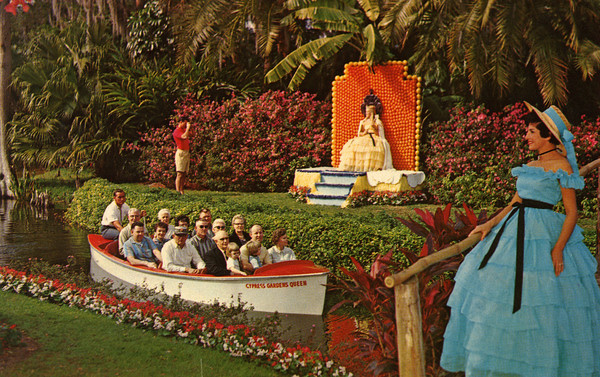I’M JUST CURIOUS: Code of Conduct for Southern Belles
/0 Comments/in I’m Just Curious/by Debbie Walker
 by Debbie Walker
by Debbie Walker
I have really enjoyed living in the south. Granted it is a bit too warm right now with our days topping off at about 97 degrees with the “feels like” 108 degrees. I don’t understand those figures. If it feels like 108, why isn’t it just 108?
I have had about enough of this ‘real world’ mess going on. You can get enough of that in just a few minutes on TV, so recently, when a friend passed on a new book to me, I decided to share some of it with you this week. The title is A Southern Belle Primer. It’s a book to have fun with, for me anyway. I hope you find it humorous as well.
A Southern Belle’s Ten Golden Rules:
1. Never serve pink lemonade at your Junior League committee meetings. It has Communist overtones. (Since I am not a Southern Belle I don’t understand this one either.)
2. Always wear white when you walk down the aisle (even if it’s for the third time)
3. Never wear white shoes before Easter or after Labor Day. The only exception, of course, is if you’re a bride. Bridesmaids, however, must never wear white shoes. Bridesmaids’ shoes should match the punch. (?)
4. It doesn’t matter if you marry a man who doesn’t know the difference between a shrimp fork and a pickle fork, you can always teach him. Just make sure he can afford to buy you both.
5. Never date your sorority sister’s ex-husband until at least three years after the divorce. You might need her to write your daughter a Kappa Kappa Gamma recommendation one day. Just remember it’s a lot easier to find a new man than it is to get your daughter into Kappa. (yeah, that is certainly one of my biggest concerns in life, how about you).
6. Never marry a man whose mother and grandmother owned silver plate instead of real silver. He’s not used to quality and he’ll try to cheat you on the divorce settlement. (Stay single, this is all too complicated!)
7. It’s never too soon to write a thank you note. Some belles take the notes and a pen with them to a party. In the middle of the evening they go into the ladies’ room and write a thank you describing how much they enjoyed the dinner (naming specific items). They then put the note in the mailbox as they leave. The hostess receives it first thing in the morning. Sure, this is compulsive, but you’re going to have to be compulsive if you want to become president of Junior League. (I looked up this Junior League thing on the internet and I will bet you becoming president of the United States is an easier process than becoming a League President!) (Yes, there really is such a thing as Junior League, a community service organization)
8. Never show off your bosom before evening and never wear an ankle bracelet before anything. Girls who wear ankle bracelets usually wind up twirling batons. There has never been a baton twirler who became Miss America and there’s certainly never been a baton twirler in Junior League. (so, I bet a tattoo is out of the question?)
9. Never chew gum in public and never smoke on the street.
10. Buy low, sell high.
The name of the book is A Southern Belle Primer, Or Why Princess Margaret Will Never Be A Kappa Kappa Gamma by Maryln Schwartz, just in case you want to study up on this stuff. Good Luck
I’m just curious if you remember the movie The Stepford Wives. Maybe those ladies would fit the criteria. What do you think? Contact me with questions or comments at DebbieWalker@townline.org.
Have a great week.
REVIEW POTPOURRI: Puccini’s La Boheme
/0 Comments/in Review Potpourri/by Peter Cates by Peter Cates
by Peter Cates
Puccini
La Boheme
Arturo Toscanini conducting the NBC Symphony, chorus and soloists; RCA Victor, LM-6006, 2 LPs, from the radio broadcasts of February 3 and 10, 1946.
The inventor of the phonograph, Thomas Edison (1847-1931), was often accused of either being tone deaf or having no taste for music, two beliefs I consider to be mainly rubbish. He personally spearheaded a wide range of music on his cylinder and flat disc record catalogs, that included popular singers, dance orchestras, country fiddlers, hymns, and operatic selections. With respect to the latter, he considered the opera La Boheme his favorite one of all and stated that the world is a better place because of its existence.
Giacomo Puccini (1858-1924) based La Boheme on Scenes of Bohemian Life by the French writer, Henri Murger (1822-1861), an episodic novel based on the lives of starving writers and artists living in Paris, including Murger’s before he achieved fame and fortune with this book. Puccini’s friend, Arturo Toscanini (1867-1957), conducted the February 1, 1896, world premiere at the Regio Theater in Turin, Italy, and it was mildly successful, unlike later productions in which it caught on with the public, who took it to their hearts and continue to do so.
Fifty years after the premiere, Toscanini conducted this NBC radio broadcast, in which its four acts were split between two Sundays. It featured tenor Jan Peerce (1904-1984) as the poet Rodolpho and soprano Licia Albanese (1909-2014) as the seamstress Mimi, with whom Rodolpho falls in love. Peerce was more gifted as a dramatic tenor but I feel his lyrical singing here was among the best I have heard in this role, right up there with Caruso, Jussi Bjoreling, Nicolai Gedda, Pavarotti etc.
Licia Albanese did her best singing in lyric roles and her Mimi was simply special.
The supporting cast, chorus and orchestra, under Toscanini’s divinely inspired leadership (with his constant, endearing, very audible humming), all performed as if their lives depended on it. Toscanini was notorious for his temper tantrums in rehearsals, often caused by wrong notes and the failure of the singers and instrumentalists to bring the same level of emotion he felt. What especially sets this Boheme apart from the other great ones was the vivid clarity of the orchestral details and their contribution to the vocal beauty.
To sum up, if there was one opera I would recommend for beginners, it’s this one.
Quote from the Maine writer/naturalist Henry Beston (1888-1968) in his 1948 book, Northern Farm, evoking the wondrous beauty sometimes found in the night sky: “It was the middle of the evening and in the north over a lonely farm, a great darkness of the forest, and one distant light, the dipper, stood on its handle, each star radiant in the blue and empty space about the pole.”
FOR YOUR HEALTH – The public health threat no one talks about: loneliness
/0 Comments/in For Your Health/by Website Editor
Nearly half of all Americans daily wrestle with loneliness, especially those over the age of 65. Being lonely can also lead to health problems. Steps can be taken to keep loneliness at bay such as early intervention, using technology to make a connection with other people.
(NAPS)—There is a public health threat looming across the United States that’s not visible to most but affects nearly half of all Americans daily: loneliness. Social isolation is as bad for your health as smoking 15 cigarettes a day and is twice as harmful as obesity.
Worst of all, loneliness is a contributing factor in senior suicides, which are rising in the U.S. While it is not something people like to think about, now more than ever, Americans must remove the stigma around mental health and spread awareness to better combat loneliness.
Many of the 12 million Americans over age 65 who live alone are entering the time of year where that lack of companionship and isolation is most palpable: winter. Whether physical or travel challenges keep seniors from attending family gatherings or the harsh weather deters them from venturing out for a social event, seniors can suffer from prolonged loneliness that can quickly manifest into more serious issues.
Loneliness does not have to be synonymous with getting older or with aging in place. Here are tips on how to help keep loneliness—and its negative health effects—at bay:
Intervene early: Spotting loneliness in yourself or someone you love can be difficult. The most common physical and behavioral signs of loneliness include persistent sadness, impaired cognitive performance, lower self-esteem, or lack of motivation and energy. Early intervention can positively affect one’s quality of life, so it’s important to address these symptoms as soon as possible before they become overwhelming.
Leverage technology: Technology can play a key role in reducing loneliness, ensuring seniors are always connected to loved ones and care teams who can monitor and interact with them. For example, Philips Cares is a mobile application that helps connect seniors who are subscribers to Philips Lifeline service with their family and friends, helping to enable these caregivers to be there for their aging loved ones, easing and enriching their aging journey.
Make a connection: Connecting with people, purpose and passions will help eliminate feelings of isolation. Consider organizing a reoccurring social gathering, such as a book club or a group fitness class. Explore local activities organized by a senior community center or find a National Council of Aging program through www.ncoa.org/ncoa-map.
Learn more
For further facts about the latest technology to help seniors stay connected with their care circle, visit https://philips.to/2MGDqLm or call (855) 223-7395.
GROWING YOUR BUSINESS: Out of adversity comes innovation
/0 Comments/in Growing Your Business/by Dan Beaulieu by Dan Beaulieu
by Dan Beaulieu
Business consultant
What do Hewlett Packard, Disney, Hyatt, MTV, CNN, Microsoft, Burger King and GE all have in common? They all started in periods of economic recessions. The ideas for these companies came from periods of great uncertainty, times when the world, especially the economic world seemed unsafe.
Does this sound familiar? Has there ever been a time of greater uncertainty than today? If so, not many. As strange as this is going to sound, and forgive me in advance for saying it, but those of us in business should never waste a good crisis. Right now, with the world upside down and people not really knowing what path to take, this is a time when those proverbial cooler heads will prevail. This is the perfect time, yes, right now to sit down and figure out in what direction to take your business.
Whatever that business might be from a Mexican restaurant, to a plumbing and heating business, to a landscaping business, this it the time to take a look at the world around you, your customers, your market and figure out first what they are going to need and, secondly, how can you and your company meet that need.
It has almost become a cliché to say that the world will never be the same, but it’s true isn’t it? We all know for a fact that after that sunny and clear Tuesday in 2001, September 11, the world has never been the same. If you don’t believe me you have not been to an airport since then. If you don’t believe me ask our service men and women who have been fighting in wars, still are fighting in wars almost 20 years later that resulted from that one day in 2001. Think of all the industries that sprang up in the aftermath of that one day. Everything from better security devices to small clear shampoo bottles, to a rise in the number of firearms, not to mention defense and aerospace equipment that has kept our military industrial community thriving since that one day.
So, what has this to you with you, small business owner in Kennebec County, Maine? It has everything to do with you and your business. It’s time you looked around and figured out how the world is changing and how you use those changes to expand your business.
Let’s take a peek at what we are watching change as we write this:
- Germ Free Service Companies: Your customers are going to be more wary of people coming into their homes to do work. So, you’d better have a plan to assure them your company practices safe policies from now on.
- Delivery services: Deliver services are booming, if you’re in the food industry, no matter what your cuisine, you should get even more creative at take-out meals, not only while this pandemic is happening but long after as well. Speaking of home delivery, services like Instacart are thriving. People don’t want to hang out in grocery stores anymore. So, what does that mean for you? Maybe people want to support a local delivery service rather than an expensive national service.
- Medical safety products: Companies producing everything from disinfectants, to wipes, to gloves and mask and shields are thriving. This is not going to go away. Maybe you have the tools to produce some of these products.
Are you getting my point? And this is only the beginning. Look around and see what you can do to adapt to these changing times and come up with new and innovative ways to grow your business.
Critter Chatter: Speaking of quarantine, part II…
/0 Comments/in Critter Chatter/by Jayne Winters by Jayne Winters
by Jayne Winters
All wild animals are hosts to parasites: internal, such as tape, hook, pin or round worms, or external, such as mites, ticks and fleas. Some of these little buggers (literally!) are also zoonotic (as noted in May’s article about rabies) and can infect animals as well as people.
Mange is an itchy skin disease caused by mites that burrow and feed under the skin or hair follicles. It’s common in foxes, but sometimes porcupines and raccoons suffer from it as well. Hair loss and crusting from scratching and biting are usually seen and may result in secondary skin infections and poor general condition. Sadly, Donald Cote, of the Duck Pond Wildlife Care Center, in Vassalboro, has had first-hand experience with this intense skin itching after disposing of a dead fox he found in the woods; a trip to the ER confirmed diagnosis and he endured several weeks of treatment.
Animals suspected to have mange must be isolated from others. It is imperative to provide consistent treatment, with thorough spraying and cleaning of pens, bedding (hay is burned), and feeding dishes. Treatment is typically an oral paste and/or topical rinses over 3-5 weeks; correct dosage is important, especially in small animals, as too much can be toxic and cause death. When ready for release, the animal is relocated to a totally different place in the wild than where it was found to avoid re-infestation from shared dens or litter mates in the area. In fact, the site is avoided for any release for a full year. I found it interesting to learn that although the Cotes had been advised any mites left in the ground during the fall would freeze over winter, they later found mites not only survived cold temps, they also moved 25 feet away to other enclosures!
Duck Pond’s first case of parvo virus was in 1991. Carleen wrote a column about its heartbreaking devastation: of 50 raccoons she had cared for, many since infancy, only nine survived. Despite extensive decontamination of the building with chlorine bleach, it resurfaced in July 1992, with only seven of 40 coons surviving. The next three years were disease-free as the Cotes isolated coons as they arrived until they were relatively sure they carried no diseases.
Parvoviruses affect carnivore species, are highly infectious and environmentally persistent. Transmission occurs when the virus is shed in the feces of an infected animal and ingested by another; young animals are at greatest risk, especially among litter mates. Clinical signs include lethargy, depression, lack of appetite and after a few days, vomiting and diarrhea. The virus can be detected in fecal samples or tissue cultures.
There is no cure, however, for parvo and it can live in the ground for years, even in the absence of sick animals. It is very difficult to treat and control once a facility has been contaminated and is resistant to many common detergents and disinfectants, as well as to changes in temperature and pH.
Although the incubation period in wild animals is extremely variable, new admissions are typically quarantined for at least two weeks and ideally tested before being in contact with other animals. Quarantine is for animals that have potentially been exposed, while isolation is for infected/symptomatic animals. A parvo isolation area must be a separate, easily disinfected area (a physically separate building is recommended) with dedicated equipment and restricted access; protective clothing should be required when entering the space (boots, gloves, water resistant clothing).There is a canine vaccine which is typically given to kits at six weeks of age, but it’s semi-live and doesn’t necessarily kill the virus in coons. Donald now prefers to send raccoon intakes to other wildlife rehabbers until they are determined to be parvo-free.
Donald Cote operates the Duck Pond Wildlife Care Center on Rte. 3 in Vassalboro. It is a nonprofit federal and state permitted rehab facility which is supported by his own resources and outside donations. Mailing address: 1787 North Belfast Ave., Vassalboro ME 04989 TEL: (207) 445-4326. EMAIL CORRECTION: thewildlifecarecenter@gmail.com.
I’M JUST CURIOUS: Does anyone else notice?
/0 Comments/in I’m Just Curious/by Debbie Walker by Debbie Walker
by Debbie Walker
Does anyone else notice that we are on one heck of a ride? No, it can’t be an amusement ride because the governor of Maine has shut down any of those for the foreseeable future. Right now, it can’t be blamed on icy roads either. However, I feel as though I am in a runaway cart careening down a huge steep hill. No one seems to be in charge of the ride.
If someone is in charge, they certainly haven’t done anything to stop it, even slow it down. It has picked up speed since they(?) took prayers out of the schools. I don’t remember the whole story behind this, but it does seem like someone demanded and they got their way, sounds like spoiled children to me. Where is the common sense? Even as a child in school back then we didn’t understand the fuss. If you had reason to not join the prayer, then you just didn’t participate.
It’s just getting disgusting, there are so many people who seem to be whining about this not being right or that being racist. It’s all amazing to me. It sounds like little kids and someone is being the bully. “If I whine enough I know I will get what I want.” Now that is not a skill that requires much training. Remember infants, they learn when they are days old, I cry and they pick me up (change me, feed me, rock me, etc). You would think by the time we become an adult we could find another way of communicating. I guess not.
There are all different kinds of judgment in this world. Racism is just one of them. What tribe, clan, group, or nationality that doesn’t have some kind of story to tell. Taking down statues, changing names of logos, changing names of businesses is not going to change the history itself.
Native Americans lost more than can be described, to the new folks who moved into their country. I wasn’t born yet and I don’t feel responsible for that abuse (robbery), do you?
Other nationalities were used as slaves over the years, but I guess I must have missed their riots, I don’t remember. Native Americans fought their battles years ago.
I know I have a habit of simplifying things. To me there is something I am not sure has been tried. Try saying no for a change and stick to it. “No, you can not tear down that statue that has stood there for X-number of years. Move on, now, go find something else to occupy your mind. Have you made your bed today?” Simplified as you would with a willful child.
I am not politically minded. I am afraid I don’t trust any of the “rulers” of our world to be honest. Words are twisted, taken out of context. Some statements are just lies. Surveys designed to show the results you want. The list goes on and on.
How does this get fixed? Where is the strength this country is known by? There is no working together unless you are doing it my way, that is not working together folks. You were originally trusted to come together and make solid decisions. Did you forget? I guess maybe we need to come up with a strong reminder.
I’m just curious about a lot of things, even curious about the craziness of our country right now. For questions or comments please contact me at DebbieWalker@townline.org and remember these are my thoughts and have nothing to do with the opinions of The Town Line newspaper.
REVIEW POTPOURRI: Victor Red Seal recordings, Wagner, & Ernestine Schumann-Heink
/0 Comments/in Review Potpourri/by Peter Cates by Peter Cates
by Peter Cates
Victor Red Seal recordings
A few Victor Red Seal recordings from the years of easily breakable 78 shellac discs.
Bruckner Symphony No. 7; Eugene Ormandy conducting the Minneapolis Symphony Orchestra; Victor, M-276, eight discs, recorded January 5th and 7th, 1935.
Before his 44 years as music director of the Philadelphia Orchestra, Eugene Ormandy (1899-1985) served in Minneapolis from 1931-1936 and made a number of records for Victor between January 16, 1934 and January 16, 1935. The 7th Symphony of Anton Bruckner (1824-1896) is a magnificent one of almost 60 minutes and scored for large orchestra with some of the most heavenly beautiful moments from a composer who was also a superb organist. When the Symphony was premiered in Vienna in 1886, the Waltz King, Johann Strauss Jr. (1825-1899), sent the following reply in a telegram – “Am much moved. It was the greatest impression of my life.”
Ormandy’s recording was one of tremendous beauty and power and still holds up well.
Wagner Die Feen Overture
Albert Coates conducting the London Symphony Orchestra; Victrola 11455, one disc, recorded in 1932.
Wagner completed his first opera, the infrequently performed Die Feen, when he was 20 years old. The Overture is decently listenable but far from the depths of his later masterworks. However, conductor Albert Coates (1882-1953) made a convincing case for it and drew tremendous playing from the London Symphony.
Coates was born in St. Petersburg, Russia, to an English businessman and his Russian-born wife and established a reputation in both England and Russia before World War I, serving as music director of the Russian Imperial Opera for five years before the 1917 Revolution. The Bolshevik government did keep him working but, by 1919, starvation threatened living conditions there, Coates fell ill, so he and his family left Russia, just barely making it to Finland and back to the United Kingdom.
Wagner
Rienzi Overture and Gotterdammerung Closing Scene; Leopold Stokowski conducting the Philadelphia Orchestra; Victor 6624/6625; 2 discs, recorded 1927.
Leopold Stokowski (1882-1977) was one of only two conductors (the other being his successor in Philadelphia, Eugene Ormandy) who recorded from the pre-1924 acoustic era to the four-channel quadraphonic one of the 1970s. Also, like his younger colleague, he left hundreds of recordings of an encyclopedic range of composers and some of his best records were the ones of the music of Richard Wagner (1813-1883). I cherish his Victor 78s of excerpts from his operas Parsifal – the Prelude and Good Friday Spell – and his Synthesis of Tristan and Isolde moments.
The above 1927 ones of Wagner’s heart-warmingly vibrant Rienzi Overture and the conclusion of Gotterdammerung (itself being five hours long and the fourth and last opera in the 16-hour Ring cycle) have a surging intensity, beauty and savagery that is implicit in the music itself, through which Stokowski doesn’t try to impose his own individuality and mannerisms as he did often in other recordings.
On June 14, 1912, Stokowski conducted the London Symphony Orchestra in an all-Wagner concert featuring the soprano Lillian “Lady” Nordica (1857-1914), who was born in Farmington, Maine, and lived her first eight years there.
Ernestine Schumann-Heink
Stille Nacht (Silent Night); Victor 88138, one disc, recorded 1908.
Contralto Ernestine Schumann-Heink (1861-1936) recorded prolifically, beginning as early as 1900 and her rich warmth and disciplined technique enabled her to sing very nicely through her last years, when she appeared at the Metropolitan Opera in Wagner’s Lohengrin at the age of 71, and had her own weekly radio show. Since I enjoy Christmas music any time of the year, preferably in small doses, I find this acoustic record from 112 years ago a good example of her ability to breathe new life into old songs and opera arias. Starting in the mid-1920s, she sang Silent Night on the radio every year during the Yuletide season.
During World War I, she gave concerts for the U.S. war effort and had three sons serving in our navy; she also had one son from her first marriage in Germany who was still living there and who was drafted into the Kaiser’s own submarine service.
FOR YOUR HEALTH: Feeding A Global Need
/0 Comments/in For Your Health/by Website Editor
Youth Hunger And Malnutrition Continue To Grow Helping children grow up strong and healthy are companies and non-profit organizations that provide kids with free meals when schools are closed. You can be part of the solution.
(NAPSI)—According to the United States Department of Agriculture, in the U.S., more than 12 million children receive free or reduced-price breakfast at school, and more than 29.7 million get lunch through the national school lunch program. For many, school meals are the only consistent food they get in a day and, while many school districts have continued distributing meals during the pandemic shutdown, when the school year ends, so do school meals. But there is hope and help.
Nationally, companies and non-profit organizations are partnering to help meet the needs in the community. One such partnership between Herbalife Nutrition and Feed the Children, a nonprofit organization, aims at solving the issue of food insecurity. The two organizations have united under the shared commitment to defeat hunger worldwide.
The Importance of Nutrition
The most vulnerable members of our society, children, rely on school meals and feeding programs to survive. Families living paycheck to paycheck may not have savings or support systems to help them. When children are guaranteed proper health and sanitation measures, they are able to prevent and fight disease, enabling them to develop both physically and mentally into strong children who become contributing members of their communities.
“As a nutrition company, we know that without adequate food and nutrition, children are unable to reach their full development potential both physically and mentally,” said Dr. Kent Bradley, Chief Health and Nutrition Officer, Herbalife Nutrition. “In working with Feed the Children, we’ve learned the extent of the issue of food insecurity.”
Disturbingly, 66 million school-age children attend classes hungry across the developing world, according to the Food and Agriculture Organization of the United Nations. As the world continues to experience fear and uncertainty, resources become scarcer. The reality is that food-insecure families, especially kids, are going to be affected more than most.
Dr. Bradley adds, “as a global company providing healthy nutrition to millions of people around the world, we have a responsibility to help those in need of good nutrition.”
According to the Food Research and Action Center, many of the children who face a nutrition gap when the school year ends also are affected disproportionately by summer learning loss. Also known as the “summer slide,” this refers to the loss of academic skills and knowledge over the summer. This means these children return to school in the fall academically behind their peers and struggling to catch up before classes even begin.
Partnering Together
Companies, individual donors and community organizations are coming together to help vulnerable families and communities to ensure that millions who have lost access to food, don’t go hungry. In addition to programmatic support for Feed the Children, the Herbalife Nutrition Foundation has already donated $50,000 to the organization for its pandemic response efforts, through the company’s Nutrition for Zero Hunger initiative.
“Through our vast network of community and corporate partners, Feed the Children continues to work each day to ensure that no child is hungry. There are a variety of ways our community partners are delivering food and household essentials including door-to-door home delivery and drive-thru product pick-ups (food, water, hygiene items). Some community partners even have a call-in number to ensure those who are homebound or quarantined receive the items they need.” says Travis Arnold, CEO and President of Feed the Children.
Feed the Children is taking action to ensure communities aren’t forgotten. Eighty percent of their standard domestic work involves supplying community partners (such as food pantries and soup kitchens) with the bulk of the items they need to do their daily work.
To help Feed the Children in these efforts by donating cash, visit www.feedthechildren.org. Businesses that can donate product (food, hygiene items, and the like) can call (800) 627-4556.
SCORES & OUTDOORS: We are entering the heart of moth season
/0 Comments/in Scores & Outdoors/by Roland D. Hallee
Left to right: Virginia Ctenucha moth, Rosy Maple moth, Pink striped oakworm moth. (photos by Roland D. Hallee)
 by Roland D. Hallee
by Roland D. Hallee
As my battle with the brown tail moth caterpillars continues, I have seen a variety of other moths emerge over the last week. I was anxious for the brown tail moth caterpillar to turn into a moth so we can cut down on the floating hairs that have been irritating our skin.
While watering my garden on Saturday, I saw a brown tail moth in flight. What a relief to see that.
However, other moths have caught my attention, and here are three of them.
The first one is the Virginia Ctenucha (pronounced ten-oo-chah) … I think.
The Virginia Ctenucha, Ctenucha virginica, is an attractive moth. It is widespread and common and is a member of the Erebidae family which consists of a varied group of striking moths living in woodlands, fields, and gardens, as well as freshwater swamps, marshes, and bogs.
The Virginia Ctenucha is the largest and most broad-winged of wasp moths in North America. Its wingspan is 1-3/8 to 2 inches. This moth has a metallic blue body, which contrasts with the bright orange of its head and the sides of its collar. Its fore wing is a deep grayish brown, with some metallic blue at the base. Its hind-wing is black.
It is endemic to eastern North America, from Newfoundland south to Virginia. According to the University of Alberta, there has been a westward expansion in the last 60 years as it has reached the Canadian rockies and is now found in all Canadian provinces. Larvae feed on a variety of host plants including various grasses, irises, and sedges. Adults drink nectar from flowers including goldenrod.
The adult Virginia Ctenucha flies primarily during the day, but may also come to light at night. Adults feed on nectar at various flowers, such as goldenrod. The larva body surface is black, covered with tufts of cream-colored or black hairs. Caterpillar hosts include grasses, sedges, and irises.
Despite its name, this is a northern moth. The flight period for the Virginia Ctenucha throughout its range is from late spring to late summer, however sighting records suggest that it flies in July. The larva can usually be seen from April to September, but may be found any time of year, since they overwinter.
Another moth I have spotted is the Rosy Maple moth, Dryocampa rubicunda, a small North American moth also known as the great silk moth. It was first described by Johan Christian Fabricius in 1793. The species is known for its wooly body and pink and yellow coloration, which varies from cream or white to bright pink or yellow. Males have bushier antennae than females, which allow them to sense female pheromones for mating.
As the common name of the species implies, the preferred host trees are maple trees. They can also be found on oak trees. Adult females lay their yellow ovular eggs in groups of 10 to 40 on the underside of maple leaves. The emerging caterpillars, also known as the greenstriped mapleworm, mainly feed on the leaves of their host maple trees, particularly red maple, silver maple, and sugar maple. Since the caterpillars eat the entire leaf blade, in dense populations, caterpillars have been known to defoliate trees, resulting in aesthetic rather than permanent damage. However, like all other Saturniid moths, the adult moths do not eat.
The rosy maple moth is the smallest of the silk moths; males have a wingspan of 1.25 – 1.75 inches).
The rosy maple moth lives across the eastern United States and adjacent regions of Canada. Their northern-most range includes the southern regions of Canada, including Ontario, Québec, New Brunswick, Nova Scotia, and Prince Edward Island. Their range extends south along the Atlantic coast of North America to Dade County, Florida, and extends west from eastern Texas through Minnesota.
Caterpillars live and feed in groups until the fourth instar when they become solitary. Adult rosy maple moths are mostly solitary besides during mating.
Individual rosy maple moths typically live for about two to nine months. Between hatching and adulthood, the species undergoes five instars. For moths with longer life spans, much of this time is spent as a pupa over the winter months.
The predators of the rosy maple moth and larvae mostly consist of birds including blue jays, black-capped chickadees, and tufted titmice. The bright coloration of the wings may serve as a defense mechanism to trick predators into thinking they are poisonous and not tasty.
Adults become active in the warmer months of the year. In a study the rosy maple moth was found to vary with changes in temperature, with highest counts at the highest temperature. The recent warm weather may have contributed to its early arrival. Their small size, preventing more effective body temperature control, may also contribute to their preference for warm weather. Adult moths are generally nocturnal, preferentially flying throughout the first third of the night.
Finally, the pink-striped oakworm moth, another species of silk moth.
The female’s wings are purplish red with ochre-yellow. They have thin scales and are almost transparent. The male’s wings are purplish brown with a large transparent space in the middle. The female is larger than the male.
The moth can be found across Canada from Nova Scotia to southeastern Manitoba, and in the United States. It lives in deciduous woodlands and suburbs.
The males attract females by buzzing like a bee. Mating occurs during the morning. It is a rapid process. The male and female stay together for the rest of the day and then the female finds a place to lay eggs, usually under oak leaves.
The caterpillars are gray or greenish with dull brownish yellow or rosy stripes. There are scales on each segment and two long spines. The caterpillars pupate for a short time. They feed on the foliage of oak trees, maples, birches, and hazels. The caterpillar overwinters in the soil as a pupa. Caterpillars that are newly hatched or are in the middle of growing, feed in groups while those that are mature or nearly so feed separately. The caterpillar is about an eighth of an inch long. The head is large in proportion to the body. The inside of the mouth is yellow. The legs are semi-translucent.
Conservation regimes are not required for this species. It is considered a pest of forests because it defoliates trees.
These are all moths I have seen around the door to our office at The Town Line.
Roland’s trivia question of the week:
Which Red Sox player holds the team record for the most Gold Glove Awards with eight?
Pages
- 2019 China Community Days: Program of Events
- About Us
- Best of The Town Line 2019
- Best of The Town Line in 2017
- Calendar of Events
- Classifieds
- Community Calendar
- Community Calendar for China (China, South China, Branch Mills, Weeks Mills)
- Contact Us
- Donate
- Food Pantries
- Hours of Worship
- Issue for April 1, 2021
- Issue for April 10, 2025
- Issue for April 11, 2024
- Issue for April 13, 2023
- Issue for April 14, 2022
- Issue for April 15, 2021
- Issue for April 17, 2025
- Issue for April 18, 2024
- Issue for April 20, 2023
- Issue for April 21, 2022
- Issue for April 22, 2021
- Issue for April 24, 2025
- Issue for April 25, 2024
- Issue for April 27, 2023
- Issue for April 28, 2022
- Issue for April 29, 2021
- Issue for April 3, 2025
- Issue for April 4, 2024
- Issue for April 6, 2023
- Issue for April 7, 2022
- Issue for April 8, 2021
- Issue for August 1, 2024
- Issue for August 10, 2023
- Issue for August 11, 2022
- Issue for August 12, 2021
- Issue for August 15, 2024
- Issue for August 17, 2023
- Issue for August 18, 2022
- Issue for August 19, 2021
- Issue for August 22, 2024
- Issue for August 24, 2023
- Issue for August 25, 2022
- Issue for August 26, 2021
- Issue for August 29, 2024
- Issue for August 3, 2023
- Issue for August 31, 2023
- Issue for August 4, 2022
- Issue for August 5, 2021
- Issue for August 8, 2024
- Issue for December 1, 2022
- Issue for December 12, 2024
- Issue for December 14, 2023
- Issue for December 15, 2022
- Issue for December 16, 2021
- Issue for December 19, 2024
- Issue for December 2, 2021
- Issue for December 21, 2023
- Issue for December 22, 2022
- Issue for December 23, 2021
- Issue for December 5, 2024
- Issue for December 7, 2023
- Issue for December 8, 2022
- Issue for December 9, 2021
- Issue for February 1, 2024
- Issue for February 10, 2022
- Issue for February 13, 2025
- Issue for February 15, 2024
- Issue for February 16, 2023
- Issue for February 17, 2022
- Issue for February 2, 2023
- Issue for February 20, 2025
- Issue for February 22, 2024
- Issue for February 23, 2023
- Issue for February 24, 2022
- Issue for February 25, 2021
- Issue for February 27, 2025
- Issue for February 29, 2024
- Issue for February 3, 2022
- Issue for February 6, 2025
- Issue for February 8, 2024
- Issue for February 9, 2023
- Issue for January 11, 2024
- Issue for January 12, 2023
- Issue for January 13, 2022
- Issue for January 16, 2025
- Issue for January 18, 2024
- Issue for January 19, 2023
- Issue for January 2, 2025
- Issue for January 20, 2022
- Issue for January 23, 2025
- Issue for January 25, 2024
- Issue for January 26, 2023
- Issue for January 27, 2022
- Issue for January 30, 2025
- Issue for January 4, 2024
- Issue for January 5, 2023
- Issue for January 6, 2022
- Issue for January 9, 2025
- Issue for July 1, 2021
- Issue for July 10, 2025
- Issue for July 11, 2024
- Issue for July 13, 2023
- Issue for July 14, 2022
- Issue for July 15, 2021
- Issue for July 18, 2024
- Issue for July 20, 2023
- Issue for July 21, 2022
- Issue for July 22, 2021
- Issue for July 25, 2024
- Issue for July 27, 2023
- Issue for July 28, 2022
- Issue for July 29, 2021
- Issue for July 3, 2025
- Issue for July 4, 2024
- Issue for July 6, 2023
- Issue for July 7, 2022
- Issue for July 8, 2021
- Issue for June 1, 2023
- Issue for June 10, 2021
- Issue for June 12, 2025
- Issue for June 13, 2024
- Issue for June 15, 2023
- Issue for June 16, 2022
- Issue for June 17, 2021
- Issue for June 19, 2025
- Issue for June 2, 2022
- Issue for June 20, 2024
- Issue for June 22, 2023
- Issue for June 23, 2022
- Issue for June 24, 2021
- Issue for June 26, 2025
- Issue for June 27, 2024
- Issue for June 29, 2023
- Issue for June 3, 2021
- Issue for June 30, 2022
- Issue for June 5, 2025
- Issue for June 6, 2024
- Issue for June 8, 2023
- Issue for June 9, 2022
- Issue for March 10, 2022
- Issue for March 11, 2021
- Issue for March 13, 2025
- Issue for March 14, 2024
- Issue for March 16, 2023
- Issue for March 17, 2022
- Issue for March 18, 2021
- Issue for March 2, 2023
- Issue for March 20, 2025
- Issue for March 21, 2024
- Issue for March 23, 2023
- Issue for March 24, 2022
- Issue for March 25, 2021
- Issue for March 27, 2025
- Issue for March 28, 2024
- Issue for March 3, 2022
- Issue for March 30, 2023
- Issue for March 31, 2022
- Issue for March 4, 2021
- Issue for March 6, 2025
- Issue for March 7, 2024
- Issue for March 9, 2023
- Issue for May 1, 2025
- Issue for May 11, 2023
- Issue for May 12, 2022
- Issue for May 13, 2021
- Issue for May 15, 2025
- Issue for May 16, 2024
- Issue for May 18, 2023
- Issue for May 19, 2022
- Issue for May 2, 2024
- Issue for May 20, 2021
- Issue for May 22, 2025
- Issue for May 23, 2024
- Issue for May 25, 2023
- Issue for May 26, 2022
- Issue for May 27, 2021
- Issue for May 29, 2025
- Issue for May 30, 2024
- Issue for May 4, 2023
- Issue for May 5, 2022
- Issue for May 6, 2021
- Issue for May 8, 2025
- Issue for May 9, 2024
- Issue for November 10, 2022
- Issue for November 11, 2021
- Issue for November 14, 2024
- Issue for November 16, 2023
- Issue for November 17, 2022
- Issue for November 18, 2021
- Issue for November 2, 2023
- Issue for November 21, 2024
- Issue for November 23, 2023
- Issue for November 24, 2022
- Issue for November 25, 2021
- Issue for November 28, 2024
- Issue for November 3, 2022
- Issue for November 30, 2023
- Issue for November 4, 2021
- Issue for November 7, 2024
- Issue for November 9, 2023
- Issue for October 10, 2024
- Issue for October 12, 2023
- Issue for October 13, 2022
- Issue for October 14, 2021
- Issue for October 17, 2024
- Issue for October 19, 2023
- Issue for October 20, 2022
- Issue for October 21, 2021
- Issue for October 24, 2024
- Issue for October 26, 2023
- Issue for October 27, 2022
- Issue for October 28, 2021
- Issue for October 3, 2024
- Issue for October 31, 2024
- Issue for October 5, 2023
- Issue for October 6, 2022
- Issue for October 7, 2021
- Issue for September 1, 2022
- Issue for September 12, 2024
- Issue for September 14, 2023
- Issue for September 15, 2022
- Issue for September 16, 2021
- Issue for September 19, 2024
- Issue for September 2, 2021
- Issue for September 21, 2023
- Issue for September 22, 2022
- Issue for September 23, 2021
- Issue for September 26, 2024
- Issue for September 28, 2023
- Issue for September 29, 2022
- Issue for September 30, 2021
- Issue for September 5, 2024
- Issue for September 7, 2023
- Issue for September 8, 2022
- Issue for September 9, 2021
- Legal Notices, Week of August 2, 2018
- Legal Notices, Week of August 30, 2018
- Local Business Directory
- Local Distribution Drops
- Order Confirmation
- Order Failed
- Our Town’s Report
- Roland’s Trivia Question, Week of August 2, 2018
- Roland’s Trivia Question, Week of January 11, 2018
- Schedule of Town Meetings 2018
- Town Line Survey Archives
- Week of April 11, 2019
- Week of April 12, 2018
- Week of April 13, 2017
- Week of April 16, 2020
- Week of April 18, 2019
- Week of April 19, 2018
- Week of April 2, 2020
- Week of April 20, 2017
- Week of April 23, 2020
- Week of April 25, 2019
- Week of April 26, 2018
- Week of April 27, 2017
- Week of April 28, 2016
- Week of April 30, 2020
- Week of April 4, 2019
- Week of April 5, 2018
- Week of April 6, 2017
- Week of April 9, 2020
- Week of August 1, 2019
- Week of August 10, 2017
- Week of August 11, 2016
- Week of August 13, 2020
- Week of August 15, 2019
- Week of August 16, 2018
- Week of August 17, 2017
- Week of August 18, 2016
- Week of August 2, 2018
- Week of August 20, 2020
- Week of August 22, 2019
- Week of August 23, 2018
- Week of August 24, 2017
- Week of August 25, 2016
- Week of August 27, 2020
- Week of August 29, 2019
- Week of August 3, 2017
- Week of August 30, 2018
- Week of August 31, 2017
- Week of August 4, 2016
- Week of August 6, 2020
- Week of August 8, 2019
- Week of August 9, 2018
- Week of December 1, 2016
- Week of December 10, 2020
- Week of December 12, 2019
- Week of December 13, 2018
- Week of December 14, 2017
- Week of December 15, 2016
- Week of December 17, 2020
- Week of December 19, 2019
- Week of December 20, 2018
- Week of December 21, 2017
- Week of December 22, 2016
- Week of December 3, 2020
- Week of December 31, 2020
- Week of December 5, 2019
- Week of December 6, 2018
- Week of December 7, 2017
- Week of December 8, 2016
- Week of February 1, 2018
- Week of February 11, 2021
- Week of February 13, 2020
- Week of February 14, 2019
- Week of February 15, 2018
- Week of February 16, 2017
- Week of February 18, 2021
- Week of February 2, 2017
- Week of February 20, 2020
- Week of February 21, 2019
- Week of February 22, 2018
- Week of February 23, 2017
- Week of February 27, 2020
- Week of February 28, 2019
- Week of February 4, 2021
- Week of February 6, 2020
- Week of February 7, 2019
- Week of February 8, 2018
- Week of February 9, 2017
- Week of January 10, 2019
- Week of January 11, 2018
- Week of January 12, 2017
- Week of January 14, 2021
- Week of January 16, 2020
- Week of January 17, 2019
- Week of January 18, 2018
- Week of January 19, 2017
- Week of January 2, 2020
- Week of January 21, 2021
- Week of January 23, 2020
- Week of January 24, 2019
- Week of January 25, 2018
- Week of January 26, 2017
- Week of January 28, 2021
- Week of January 3, 2019
- Week of January 30, 2020
- Week of January 31, 2019
- Week of January 4, 2018
- Week of January 5, 2017
- Week of January 7, 2021
- Week of January 9, 2020
- Week of July 11, 2019
- Week of July 12, 2018
- Week of July 13, 2017
- Week of July 14, 2016
- Week of July 16, 2020
- Week of July 18, 2019
- Week of July 19, 2018
- Week of July 2, 2020
- Week of July 20, 2017
- Week of July 21, 2016
- Week of July 23, 2020
- Week of July 25, 2019
- Week of July 26, 2018
- Week of July 27, 2017
- Week of July 28, 2016
- Week of July 30, 2020
- Week of July 4, 2019
- Week of July 5, 2018
- Week of July 6, 2017
- Week of July 7, 2016
- Week of July 9, 2020
- Week of June 1, 2017
- Week of June 11, 2020
- Week of June 13, 2019
- Week of June 14, 2018
- Week of June 15, 2017
- Week of June 18, 2020
- Week of June 20, 2019
- Week of June 21, 2018
- Week of June 22, 2017
- Week of June 23, 2016
- Week of June 25, 2020
- Week of June 27, 2019
- Week of June 28, 2018
- Week of June 29, 2017
- Week of June 30, 2016
- Week of June 4, 2020
- Week of June 6, 2019
- Week of June 7, 2018
- Week of June 8, 2017
- Week of March 1, 2018
- Week of March 12, 2020
- Week of March 14, 2019
- Week of March 15, 2018
- Week of March 16, 2017
- Week of March 19, 2020
- Week of March 2, 2017
- Week of March 21, 2019
- Week of March 22, 2018
- Week of March 23, 2017
- Week of March 26, 2020
- Week of March 28, 2019
- Week of March 29, 2018
- Week of March 30, 2017
- Week of March 5, 2020
- Week of March 7, 2019
- Week of March 8, 2018
- Week of March 9, 2017
- Week of May 10, 2018
- Week of May 11, 2017
- Week of May 14, 2020
- Week of May 16, 2019
- Week of May 17, 2018
- Week of May 18, 2017
- Week of May 2, 2019
- Week of May 21, 2020
- Week of May 23, 2019
- Week of May 24, 2018
- Week of May 25, 2017
- Week of May 28, 2020
- Week of May 3, 2018
- Week of May 30, 2019
- Week of May 31, 2018
- Week of May 4, 2017
- Week of May 7, 2020
- Week of May 9, 2019
- Week of November 1, 2018
- Week of November 10, 2016
- Week of November 12, 2020
- Week of November 14, 2019
- Week of November 15, 2018
- Week of November 16, 2017
- Week of November 17, 2016
- Week of November 19, 2020
- Week of November 2, 2017
- Week of November 21, 2019
- Week of November 22, 2018
- Week of November 23, 2017
- Week of November 24, 2016
- Week of November 26, 2020
- Week of November 28, 2019
- Week of November 29, 2018
- Week of November 3, 2016
- Week of November 30, 2017
- Week of November 5, 2020
- Week of November 7, 2019
- Week of November 8, 2018
- Week of November 9, 2017
- Week of October 1, 2020
- Week of October 10, 2019
- Week of October 11, 2018
- Week of October 12, 2017
- Week of October 13, 2016
- Week of October 15, 2020
- Week of October 17, 2019
- Week of October 18, 2018
- Week of October 19, 2017
- Week of October 20, 2016
- Week of October 22, 2020
- Week of October 24, 2019
- Week of October 25, 2018
- Week of October 26, 2017
- Week of October 27, 2016
- Week of October 29, 2020
- Week of October 3, 2019
- Week of October 31, 2019
- Week of October 4, 2018
- Week of October 5, 2017
- Week of October 6, 2016
- Week of October 8, 2020
- Week of September 1, 2016
- Week of September 10, 2020
- Week of September 12, 2019
- Week of September 13, 2018
- Week of September 14, 2017
- Week of September 15, 2016
- Week of September 17, 2020
- Week of September 19, 2019
- Week of September 20, 2018
- Week of September 21, 2017
- Week of September 22, 2016
- Week of September 24, 2020
- Week of September 26, 2019
- Week of September 27, 2018
- Week of September 28, 2017
- Week of September 29, 2016
- Week of September 3, 2020
- Week of September 5, 2019
- Week of September 6, 2018
- Week of September 7, 2017
- Week of September 8, 2016
Categories
- 30 Years Ago
- A Bible Moment
- AARP NEWS YOU CAN USE
- AARP Outreach
- AARP Scam Alert
- Albion
- Alna
- Anson
- April Fools Day
- Around the Kennebec Valley
- Athens
- Auburn
- Augusta
- Bar Harbor
- Belfast
- Belgrade
- Benton
- Bingham
- Branch Mills
- Burnham
- Business Directory
- Business News
- Canaan
- Carrabec
- Central ME
- Chelsea
- Chesterville
- China
- Classifieds
- Clinton
- Columns
- Common Ground
- Community
- Community Commentary
- Coopers Mills
- Cornville
- Corrections
- COVID-19
- Critter Chatter
- Damariscotta
- East Madison
- Editorial
- Elections
- Ellsworth
- Embden
- Eric's Tech Talk
- Erskine
- Events
- Fairfield
- Farmgirl at Heart
- Farmington
- Fiction
- Financial Focus
- Fishy Photo
- For Your Health
- Freedom
- FrontPage
- FYI
- Garden Works
- Gardiner
- Give Us Your Best Shot
- Give Us Your Best Shot!
- Growing Your Business
- Hallowell
- Hallowell
- Hampden
- Hibberts Gore
- Hinckley
- Holidays
- Hours of Worship
- I’m Just Curious
- If Walls Could Talk
- INside the OUTside
- Jefferson
- Kennebec County
- Knox-Lincoln
- Lake Life Today
- Legal Notices
- Letters to the Editor
- Lewiston
- Liberty
- Life on the Plains
- Lincoln County
- Local History
- Madison
- Maine History
- Maine Memories
- Maine Savings for Mainers
- Maine-ly Gardening
- Manchester
- Marshwood
- Messalonskee
- Messing About in the Maine Woods
- Montville
- Mount Merici
- My Point of View
- News
- Nonprofit Spotlight
- Norridgewock
- North Anson
- Oakland
- Obituaries
- Opinion
- Oxford
- Pages in Time
- Palermo
- Photo
- Pittsfield
- Pittston
- Platter Perspective
- Poems
- Poetry Corner
- Police Log
- Politics
- Quinn Minute
- Raymond
- Review Potpourri
- Rockport
- Rome
- Rotary Club News
- Sanford
- School News
- Scores & Outdoors
- Searsport
- Sheepscot Pond
- Sidney
- Skowhegan
- Small Space Gardening
- Smithfield
- Solon
- Solon & Beyond
- Somerset County
- Somerville
- South China
- Special Features
- Sports
- Standish
- Starks
- Student Writers' Program
- Support The Town Line
- The Best View
- The Frugal Mainer
- The House by Peg Pellerin
- The Money Minute
- Three Mile Pond
- Tim's Tunes
- Topsham
- Town Services
- Training Your Dog
- Trash Talk
- Trivia Question
- Uncategorized
- Union
- Unity
- Up and Down the Kennebec Valley
- Vassalboro
- Veteran's Corner
- Voting Guide
- Waldoboro
- Washington
- Waterville
- Webber Pond
- Webber Pond Comic
- Weeks Mills
- Whitefield
- Why We Observe
- Windsor
- Winslow
- Winthrop
- Wiscasset






